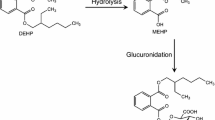Summary
Anesthetized male rats with a bile fistula received 25 mg/kg 35S-labeled perazine (Per) i.p. and bile fractions were collected for 4 h. Per and its metabolites were measured in bile, various organs and the residual cadaver by reverse isotope dilution. Nearly half of the administered radioactivity appeared in bile, major metabolites being the glucuronides of hydroxyperazine (OH-Per) and hydroxydesmethylperazine (OH-DMP) and polar non-hydrolyzable conjugates. The fraction of unconjugated compounds contained small quantities of Per and desmethylperazine (DMP). Excretions of total radioactivity, OH-Per glucuronide and polar conjugates were significantly reduced when rats had been pretreated for 7 days with 50 mg/kg Per p.o. When 5 mg/kg 35S-Per was injected into the portal vein of bile fistula rats and bile was collected for 2 h, excretion proceeded faster than in the former case, but the composition of biliary metabolites was the same as in rats treated i.p., and the same effects of Per pretreatment were observed.
N-[γ-(Phenothiazinyl-10)-propyl]-ethylenediamine (PPED) which accumulated upon repeated Per administration was most probably not responsible for the impairment of aromatic hydroxylation, since oral application of PPED did not influence the biliary excretion of OH-Per glucuronide following i.p. dosage with 25 mg/kg Per.
The predominant tissue metabolite besides Per was DMP; in liver, also PPED was present in considerable quantities. DMP concentrations in liver and brain were increased by Per pretreatment.
Experiments in which OH-Per or DMP was administered to bile fistula rats revealed that OH-DMP was predominantly produced via DMP.
It is concluded that pretreatment of rats with Per interferes with the hepatic hydroxylation of Per to OH-Per with subsequent decrease of biliary excretion of its glucuronide.
Similar content being viewed by others
References
Bray, G. A.: A simple efficient liquid scintillator for counting aqueous solutions in a liquid scintillation counter. Anal. Biochem. 1, 279–285 (1960)
Breyer, U.: Urinary metabolites of 10-[3′-(4″-methyl-piperazinyl)-propyl]-phenothiazine (perazine) in psychiatric patients. I. Isolation, identification and determination of metabolites. Biochem. Pharmacol. 18, 777–788 (1969)
Breyer, U.: Metabolism of the phenothiazine drug perazine by liver and lung microsomes from various species. Biochem. Pharmacol. 20, 3341–3351 (1971)
Breyer, U.: Petazine, chlorpromazine and imipramine as inducers of microsomal drug metabolism. Naunyn-Schmiedeberg's Arch. Pharmacol. 272, 277–288 (1972a)
Breyer, U.: Accumulation and elimination of a novel metabolite during chronic administration of the phenothiazine drug perazine to rats. Biochem. Pharmacol. 21, 1419–1429 (1972b)
Breyer, U., Junginger, W., Villumsen, D.: Phenobarbital-induced prolongation of half-life and alteration of distribution of a phenothiazine drug metabolite in the rat. Biochem. Pharmacol. 25, 2623–2629 (1976)
Breyer, U., Winne, D.: Absorption and metabolism of the phenothiazine drug perazine in the rat intestinal loop. Biochem. Pharmacol. 26, 1275–1280 (1977)
Caldwell, J., Dring, L. G., Williams, R. T.: The biliary excretion of amphetamine and methamphetamine in the rat. Biochem. J. 124, 16P-17P (1971)
Dreyfuss, J., Ross, J. J., Jr., Schreiber, E. C.: Biological disposition and metabolic fate of fluphenazine-14C in the dog and rhesus monkey. J. Pharm. Sci. 60, 821–825 (1971)
Gaertner, H. J., Breyer, U., Liomin, G.: Metabolism of trifluoperazine, fluphenazine, prochlorperazine and perphenazine in rats: In vitro and urinary metabolites. Biochem. Pharmacol. 23, 303–311 (1974)
Hirom, P. C., Millburn, P., Smith, R. L., Williams, R. T.: Species variations in the threshold molecular-weight factor for the biliary excretion of organic anions. Biochem. J. 129, 1071–1077 (1972)
Hirom, P. C., Millburn, P. M., Smith, R. L.: Bile and urine as complementary pathways for the excretion of foreign organic compounds. Xenobiotica 6, 55–64 (1976)
Hobbs, D. C.: Metabolism of thiothixene. J. Pharm. Sci. 57, 105–111 (1968)
Jahns, I., Breyer, U.: The rat brain as a “deep compartment” in the kinetics of a common metabolite of prochlorperazine and perphenazine. Drug Metab. Dispos. 4, 522–529 (1976)
Petruch, F., Schüppel, R., Breyer, U.: Änderung des Arzneimittelabbaus in der Leber unter der Behandlung mit Perazin. Arzneim.-Forsch. 26, 1154–1155 (1976)
Phillips, B. M., Miya, T. S.: Disposition of S35-prochlorperazine in the rat. J. Pharm. Sci. 53, 1098–1101 (1964)
Van Loon, E. J., Flanagan, T. L., Novick, W. M., Maas, A. R.: Hepatic secretion and urinary excretion of three S35-labeled phenothiazines in the dog. J. Pharm. Sci. 53, 1211–1213 (1964)
West, N. R., Vogel, W. H.: Absorption, distribution and excretion of trifluoperazine in rats. Arch. Int. Pharmacodyn. Ther. 215, 318–335 (1975)
Author information
Authors and Affiliations
Rights and permissions
About this article
Cite this article
Breyer, U., Jahns, I., Irmscher, G. et al. Kinetics of 35S-perazine in the bile fistula rat. Naunyn-Schmiedeberg's Arch. Pharmacol. 300, 47–56 (1977). https://doi.org/10.1007/BF00505079
Received:
Accepted:
Issue Date:
DOI: https://doi.org/10.1007/BF00505079




